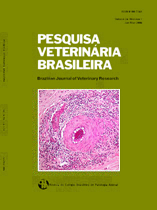 |
|
|
|
Year 2012 - Volume 32, Number 6
|

|
Behavior of cells of immune system to the challenge with Salmonella Enteritidis in birds treated and untreated with organic acids, 32(6):495-502
|
ABSTRACT.- Flores F., Lovato M., Wilsmann C.G., Gazoni F.L., Silveira F., Caron L.F. & Beirão B.C.B. 2012. [Behavior of cells of immune system to the challenge with Salmonella Enteritidis in birds treated and untreated with organic acids.] Comportamento de células do sistema imune frente ao desafio com Salmonella Enteritidis em aves tratadas e não tratadas com ácidos orgânicos. Pesquisa Veterinária Brasileira 32(6):495-502. Departamento de Medicina Veterinária Preventiva, Centro de Ciências Rurais, Universidade Federal de Santa Maria, Av. Roraima 1000, Santa Maria, RS 97105-900, Brazil. E-mail: fer_vetfb@yahoo.com.br
Salmonellosis is an important zoonosis, considered the leading cause of bacterial infections, and is associated with the consumption of poultry products. As alternative control, organic acids have been widely used. However, little is known about the immune status of poultry production, and an evaluation of this status is necessary to protect against disease and to ensure the safe application of therapeutic agents or prophylactic vaccination. This study aimed to verify the behavior of the immune system of birds previously infected with Salmonella Enteritidis (SE) treated with a compound of organic acids in different concentrations administered via water and food, compared with the infected birds and untreated. One hundred and twenty broilers were orally inoculated with 1ml of SE at a concentration of 1.0x108 CFU/mL, at 1 and 2-days-old and divided into six treatments with two repetitions of 200, 400, 500 and 1000ppm organic acid. From 35-days-old birds of all groups were collected aliquots of 3mL of blood into a tube containing EDTA for the evaluation of immune cells by flow cytometry. We then analyzed the percentages of circulating CD4+, CD8β+, MHC I+ MHC II+, TCRVβ1+, CD28+ + and TCRVβ2. For microbiological analysis were collected caecal tonsils of these birds. We found that organic acids in dosages 1000ppm 500ppm in water and in feed for 2 to 7 days before slaughter, respectively, were effective in reducing SE infection in broilers, proven by microbiological method and demonstrated through the behavior of immune cells. The infected birds showed a lower proportion of circulating T helper cells compared with infected poultry, but treated with AO or with the uninfected group. The same trend can be observed for CD28+ cells, and MHC IIbright+ TCRVβ 1+, and with lower resolution, for CD8β+. |
| |
|
|
| |
|
 |